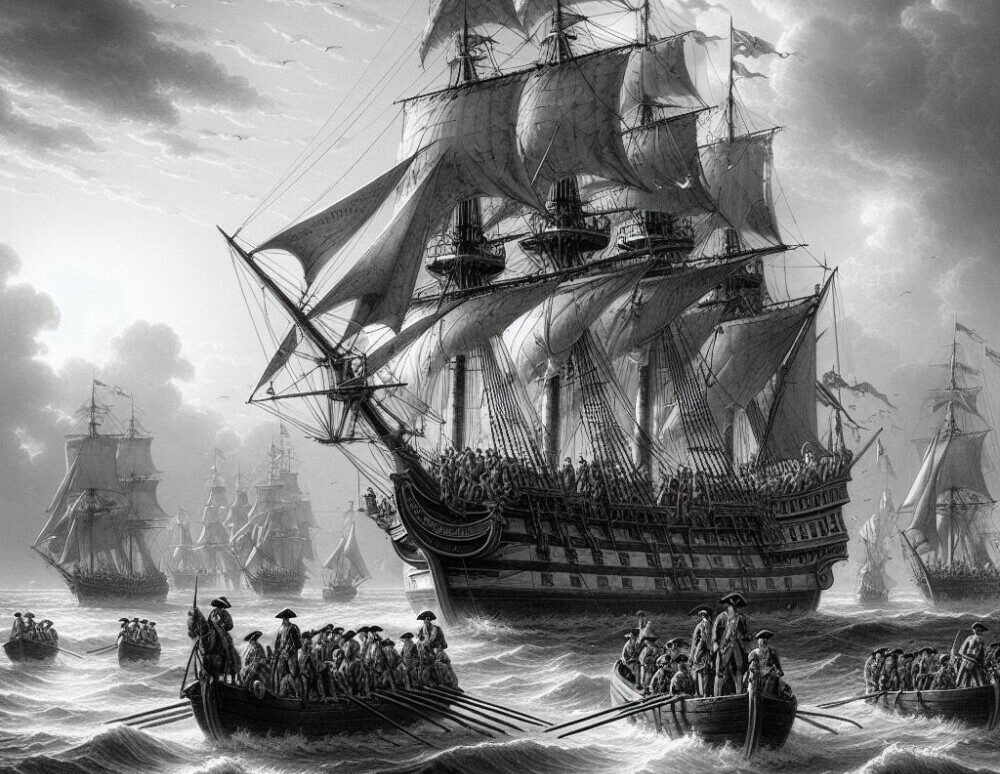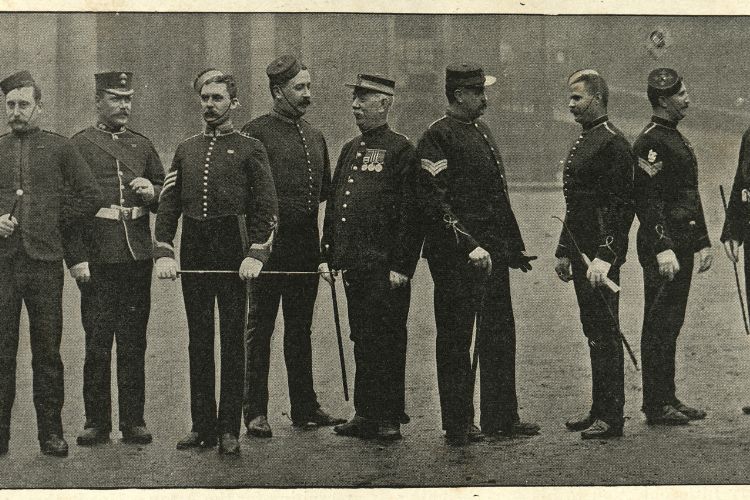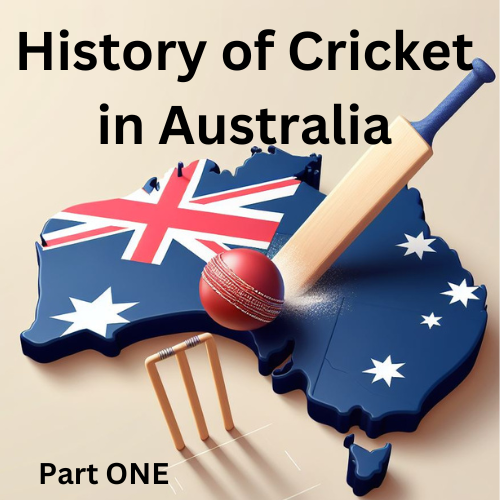Welcome to this five part History of Cricket in Australia blog post. Part One will take us from the days of Colonial Australia, to the beginnings of World War II. To expect I can reduce decades of Australian cricket history into mere short paragraphs is ludicrous. You could write volumes, and people have, detailing Australia’s cricket history, but I hope you enjoy these brief snippets that give you some idea as to the highs and lows of Australian cricket throughout the course of history, and why the sport means so much to Australians.
Origins of Cricket in Colonial Australia
The arrival of cricket in Australia is intrinsically tied to British colonization. As British settlers arrived on the continent in the late 18th century, they brought with them their cultural practices, including the game of cricket.
The earliest recorded instance of cricket being played in Australia dates back to 1803 in Sydney. This game was played by members of the British military garrison and the settlers, marking the beginning of cricket’s journey in the country.
Early settlers played a significant role in spreading the game throughout the colonies. Soldiers and expatriates, who were already familiar with cricket, organized matches and established informal cricket clubs. These matches were often social events, providing entertainment and a sense of community for the settlers in their new environment.
The establishment of formal cricket clubs, such as the Melbourne Cricket Club in 1838, further facilitated the game’s growth and structured development.

Cricket was initially perceived as a pastime for the British elite and military personnel. However, it gradually gained popularity among the broader population, transcending class boundaries. By the mid-19th century, cricket had become a significant part of Australian social life, with matches drawing large crowds and garnering media attention.
The game was embraced for its competitive spirit and the values it promoted, such as sportsmanship and fair play.
Cricket’s adoption in Australian society was not without its challenges. The harsh climate and vast distances between settlements posed logistical issues.
Nevertheless, the determination of cricket enthusiasts ensured that the sport thrived. By the end of the 19th century, cricket had established itself as a cornerstone of Australian culture, laying the foundation for the country’s future success in the sport.
Formation of Early Clubs: Establishing the Cricket Culture
The founding of the Melbourne Cricket Club (MCC) in 1838 marked a significant milestone in the establishment of cricket culture in Australia. The MCC was one of the first formal cricket clubs in the country, providing a structured environment for enthusiasts to play and organize matches. Its establishment laid the foundation for cricket as an organized sport, promoting the game’s growth and popularity.
Following the formation of the MCC, other early cricket clubs began to emerge in major cities across Australia.
Sydney saw the creation of the Sydney Cricket Club, while Adelaide and Hobart also established their own cricket clubs. These clubs played a crucial role in fostering local talent and providing a platform for competitive cricket.
They organized regular matches and competitions, which not only entertained the public but also helped in honing the skills of local cricketers.
The influence of these early clubs on the growth and structure of cricket in Australia was profound. They were instrumental in promoting cricket as a key social activity, encouraging people from various backgrounds to participate.
The clubs also contributed to the development of cricket infrastructure, including the construction of dedicated cricket grounds and facilities. This infrastructure was essential for the game’s expansion, allowing more people to play and watch cricket.
Furthermore, these clubs established a framework for the administration and governance of cricket in Australia. They introduced rules and regulations, ensuring that the game was played in a fair and organized manner. The clubs also facilitated inter-club competitions, leading to the development of regional and eventually national cricket tournaments.
Cricket Under Colonial Influence: Growth and Challenges
As British influence permeated various aspects of colonial life, cricket became a prominent part of the social and cultural landscape. The colonial administration’s support and promotion of British traditions, including cricket, helped establish the game as a respected and widely played sport.

British military personnel and expatriates played a crucial role in spreading cricket throughout the colonies. Soldiers stationed in Australia frequently organized matches, providing entertainment and a sense of familiarity in their new environment.
These matches often involved local settlers, fostering interest and participation in the game. Expatriates, who brought their love for cricket from England, also established clubs and organized competitions, further embedding the sport into Australian society.
Early cricketers and organizers grappled with issues related to infrastructure and resources. The construction of dedicated cricket grounds and the availability of quality equipment were often limited, hindering the game’s development.
Furthermore, the amateur nature of early cricket meant that players and organizers had to balance their passion for the sport with their professional and personal commitments.
Inter-Colonial Rivalries: The Birth of Competitive Spirit
The inception of inter-colonial matches in Australia began with the historic clash between Victoria and New South Wales in 1851. This match marked the beginning of a competitive cricket culture in Australia, laying the foundation for the intense rivalries that would characterize Australian cricket.
These early inter-colonial matches played a crucial role in fostering a competitive spirit among Australian cricketers and spectators. The matches attracted significant public interest, drawing large crowds and media attention.
The rivalry between the colonies added an element of excitement and prestige to the games, encouraging players to perform at their best. These contests also provided a platform for local talent to showcase their skills and gain recognition, contributing to the development of cricketing standards across Australia.
The evolution of inter-colonial tournaments further unified Australian cricket. As these matches became more frequent and formalized, they led to the establishment of structured competitions, such as the Sheffield Shield, which began in 1892-93.
The Sheffield Shield provided a regular, competitive framework for inter-colonial cricket, promoting high standards of play and consistent improvement among the teams. The tournament also played a pivotal role in identifying and nurturing talent, serving as a stepping stone for players aspiring to represent Australia at the international level.
Establishing Iconic Cricket Venues
The origins and development of key cricket grounds, particularly the Melbourne Cricket Ground (MCG), have played a vital role in the history of Australian cricket. Established in 1853, the MCG quickly became a centerpiece for cricket in Australia. Its vast expanse and state-of-the-art facilities have made it one of the most iconic cricket venues globally.

Cricket played at the MCG in 1864 Design by François Cogné (1829–1883), published by Charles Troedel (1835–1906), Public domain, via Wikimedia Commons
Other significant cricket grounds also contributed to the growth of cricket in Australia. The Sydney Cricket Ground (SCG), established in 1848, and the Adelaide Oval, opened in 1871, are renowned for their picturesque settings and rich history. These venues have been central to hosting major domestic and international matches, providing platforms for memorable performances and historic events.
The role of these cricket grounds extends beyond merely hosting matches. They have been instrumental in promoting cricket as a major sport in Australia. The large spectator capacities and advanced facilities of these venues have attracted crowds in the tens of thousands, creating a vibrant and enthusiastic atmosphere for cricket. These grounds have also been sites for significant cricketing milestones and records, further enhancing their reputation and allure.
The First Tests
The first cricket Test match, held at the Melbourne Cricket Ground (MCG) in 1877, marked the beginning of Australia’s journey on the international cricket stage. This historic match was played between Australia and England, setting the foundation for one of the most enduring rivalries in sports history.
The Australian team, captained by Dave Gregory, emerged victorious, with Charles Bannerman scoring the first-ever Test century. This landmark event not only showcased the talent of Australian cricketers but also established cricket as a major sporting event in the country.
Following the success of the first Test match, the first international tour by an Australian team to England took place in 1878. This tour was a significant milestone, as it provided Australian cricketers the opportunity to compete against the best players in the world.
The team, led by Dave Gregory, played several matches, including a notable game against the MCC at Lord’s. Australia’s performance, particularly Fred Spofforth’s exceptional bowling, earned them widespread acclaim and respect. The success of this tour helped to raise the profile of Australian cricket and fostered a sense of national pride.
The Ashes series is perhaps the most iconic element of Australia’s international cricket engagements. It originated from a single Test match at The Oval in London, where Australia defeated England on their home soil for the first time. A satirical obituary published in a British newspaper claimed that English cricket had died, and “the body will be cremated and the ashes taken to Australia.”
This gave birth to the Ashes series, a fiercely contested rivalry that has captivated cricket fans for generations. The Ashes series not only intensified the competition between Australia and England but also contributed to the development of cricketing traditions and camaraderie.
The development of Australia as a formidable cricketing nation was significantly influenced by these early international engagements. Competing against England and touring overseas provided Australian cricketers with invaluable experience and exposure to high-level competition.
These encounters highlighted the skill and resilience of Australian players, solidifying their reputation on the global stage. The success in international matches fostered a sense of national pride and unity, further embedding cricket into the Australian cultural identity.
Moreover, these international engagements spurred advancements in the organization and infrastructure of Australian cricket. The need to compete at the highest level led to the development of better training facilities, more structured domestic competitions, and a focus on nurturing young talent.
The achievements of early Australian cricketers on the world stage laid the groundwork for future successes, establishing Australia as a cricketing powerhouse and setting the stage for its dominance in the sport for generations to come.
Best Cricketers of the 19th Century
The 19th century saw the emergence of several exceptional cricketers who significantly shaped Australian cricket. Among them George Giffen, and Jack Blackham stand out for their remarkable achievements and lasting contributions to the game.

George Giffen approximately 1895 [1], Public domain, via Wikimedia Commons
George Giffen was another influential figure in 19th-century Australian cricket. Renowned for his all-round abilities, Giffen excelled as both a batsman and a bowler. Giffen’s versatility and consistent performances made him a cornerstone of the Australian team during his career. His contributions were critical in establishing Australia as a competitive force in international cricket, and his records stood for many years as a testament to his prowess.

Charles Bannerman 1970 State Library of New South Wales, Public domain, via Wikimedia Commons
Charles Bannerman is renowned for scoring the first-ever Test century in the inaugural Test match between Australia and England in 1877. His remarkable innings of 165 runs set a high standard for Australian cricket and demonstrated the potential of local talent on the international stage. Bannerman’s performance not only secured his place in cricketing history but also inspired future generations of Australian cricketers to aim for excellence.

Fred Spofforth, 1897 Credit: "From photo by E. Hawkins & Co., Brighton", Public domain, via Wikimedia Commons
Fred Spofforth, known as “The Demon Bowler,” was a key figure in establishing Australia’s reputation as a formidable cricketing nation. His exceptional bowling skills were highlighted during the 1882 tour of England, where he took 14 wickets in a match against the MCC at The Oval, a performance that remains legendary. Spofforth’s ability to intimidate and outfox batsmen made him one of the most feared bowlers of his time, and his success played a significant role in popularizing cricket in Australia.
The Stats: Australian Stats between 1877 and 1900
Between 1877 and 1900, Australia played 56 tests, all of them against England. Their win/loss/draw record was 20/26/10.
Australia’s top 5 batsmen for this time period were:
G Giffen : 31 Tests, 1238 runs; average of 23.36, 1 centuries, high score of 161
J Darling : 18 Tests, 1139 runs; average of 35.59, 3 centuries, high score of 178
SE Gregory : 24 Tests, 1096 runs; average of 28.1, 3 centuries, high score of 201
AC Bannerman : 27 Tests, 1035 runs; average of 22.02, 0 centuries, high score of 94
PS McDonnell: 19 Tests, 955 runs; average of 28.94, 3 centuries, high score of 147
Australia’s top 5 bowlers for this time period were:
G Giffen : 31 Tests, 103 wickets; average of 27.1, 7 x 5 wicket/innings, best bowling of 7/117
CTB Turner : 17 Tests, 101 wickets; average of 16.53, 3 x 5 wicket/innings, best bowling of 7/43
FR Spofforth : 18 Tests, 94 wickets; average of 18.41, 6 x 5 wicket/innings, best bowling of 7/44
GE Palmer : 17 Tests, 78 wickets; average of 21.51, 5 x 5 wicket/innings, best bowling of 7/65
H Trumble: 19 Tests, 63 wickets; average of 25.63, 3 x 5 wicket/innings, best bowling of 6/30
Conclusion
This is the end of part one. Part two of the History of Cricket in Australia will focus on the first half of the 20th century. If you want to talk more about the history of cricket from these early days of the game, add your two shillings worth in the comments and let’s get a conversation started.

